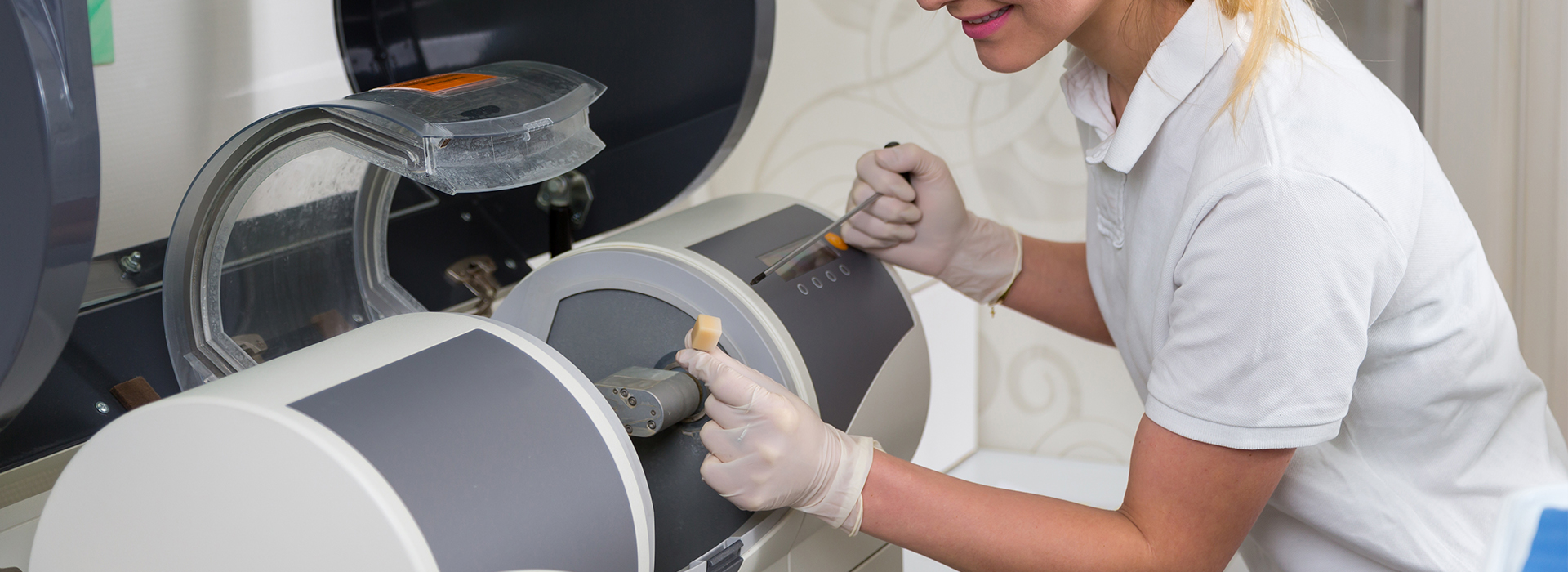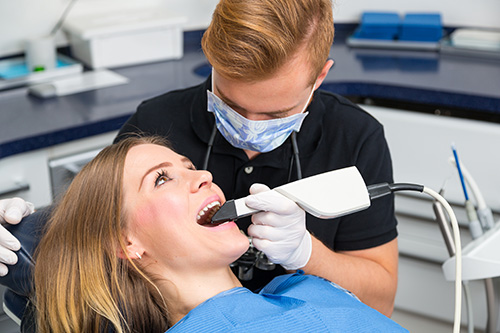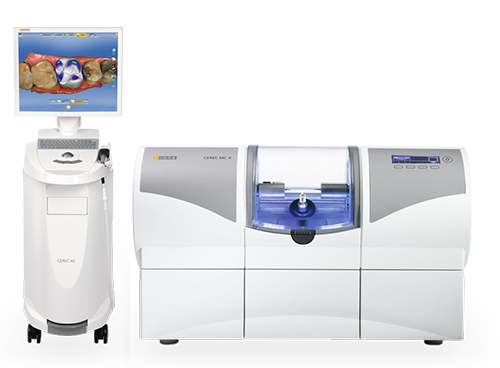North Haven Office

Our Offices
41 Middletown Ave
North Haven, CT 06473
Existing Patients: (203) 234-3900
New Patients: (203) 309-2799
Cromwell Office


CEREC represents an integrated digital approach that brings computer-aided design and manufacturing directly into the treatment room. Instead of sending molds out to a dental laboratory and waiting for multiple visits, clinicians use advanced software and a chairside milling unit to design and fabricate restorations while the patient is present. The result is a restoration produced in hours rather than days—delivering convenience while maintaining attention to fit and form.
Beyond speed, CEREC emphasizes consistency and control. The dentist oversees every step: the digital scan, the design phase, the milling process, and the final finish. This continuity reduces opportunities for miscommunication between the clinic and an external lab, and it allows clinicians to fine-tune the restoration’s shape, contacts, and occlusion before the patient leaves the office. For many patients, that single-visit resolution reduces anxiety and simplifies care planning.
At Nova Dental, our use of CEREC aligns with a philosophy of combining proven clinical techniques with modern technology to produce natural-looking, functional restorations. We select restorative ceramics and milling strategies that balance strength and aesthetics so that each restoration performs well and blends seamlessly with the surrounding teeth.

The CEREC process begins with a high-resolution intraoral scan that captures detailed 3D images of the prepared tooth and adjacent structures. This replaces traditional impression materials with a comfortable, quick scan that many patients find easier to tolerate. The digital model shows precise margins and surface anatomy, giving the clinician a reliable foundation to plan a restoration that fits the patient’s bite and smile contours.
Once the scan is complete, the design phase uses specialized CAD software to create a restoration that respects occlusion, contact points, and aesthetic needs. The dentist can adjust shape, length, and contour on-screen, previewing how the final piece will integrate with surrounding teeth. After approval, the design is sent to the on-site milling unit, which carves the restoration from a block of high-quality ceramic while the patient remains comfortably seated.
The convenience of this digital workflow doesn’t sacrifice precision. Digital scans eliminate common errors associated with impression material distortion, and the ability to immediately view and revise the proposed restoration reduces surprises at delivery. For patients who prefer efficiency and fewer appointments, this approach is a practical alternative to traditional multi-visit workflows.

CEREC restorations are milled from high-strength ceramic blocks formulated for dental restorations. These materials combine fracture resistance with optical properties that mimic natural tooth structure, so the finished crown, inlay, or onlay can be shaded and glazed to harmonize with adjacent teeth. Modern ceramics also respond well to adhesive bonding protocols, helping the restoration integrate mechanically and esthetically with tooth structure.
Properly executed bonding techniques and occlusal adjustments are critical to long-term success. The CEREC workflow allows clinicians to complete those steps in one visit: try-in, minor contour adjustments, surface treatment, and adhesive cementation are performed immediately after milling and finishing. When combined with conservative preparation designs that preserve healthy tooth structure, this approach supports lasting performance and patient comfort.
Clinical decision-making remains essential. While CEREC ceramics perform well across many indications, the dentist evaluates each case for material choice, design strength, and occlusal dynamics. That clinical judgment—the combination of digital precision and professional expertise—is what ensures a restoration that is both durable and visually appropriate for a patient’s smile.

CEREC is versatile and well-suited for a range of restorative needs. Single-unit crowns are among the most common uses, offering a predictable option for teeth that require full-coverage protection. Inlays and onlays provide a conservative choice when decay or old restorations can be repaired without removing substantial tooth structure. The precision of the digital design yields restorations with accurate margins and smooth occlusal surfaces.
Clinicians also employ CEREC for minor esthetic corrections and for replacing fractured or failing restorations when clinical conditions permit. The digital workflow supports individualized designs for challenging shapes, helping to restore function without overpreparing the tooth. Each case is evaluated for suitability, taking into account remaining tooth structure, bite forces, and the patient’s oral health history.
Because the restoration is made and delivered in the same visit, patients avoid temporary crowns and the risk of interim complications. That immediate transition from preparation to permanent restoration can simplify scheduling and lower the chance of exposure-related issues that sometimes occur between appointments.
A typical CEREC appointment begins with a focused exam and treatment planning conversation. After local anesthesia is administered as needed, the tooth is prepared conservatively and an intraoral scan captures the preparation and surrounding dentition. The on-screen design is reviewed with the patient when appropriate, and milling begins once the restoration is approved. Milling and finishing usually take under an hour, depending on complexity, while small adjustments and polishing complete the visit.
Following cementation, the restoration is evaluated for occlusion, contacts, and smoothness. Patients may notice minor sensitivity for a short period as the tooth adapts, which is typically manageable with routine measures. Care instructions focus on routine oral hygiene, avoidance of very hard or sticky foods immediately after treatment, and maintaining regular dental check-ups to monitor the restoration over time.
Long-term success depends on preventive care and sensible habits. Good daily hygiene, routine professional cleanings, and prompt attention to any changes in sensation or fit help protect the restoration and surrounding teeth. If recommended, the dentist will schedule follow-up visits to confirm that margins remain healthy and the occlusion stays balanced.
Summary and Next Steps
CEREC brings a contemporary, evidence-informed option to restorative dentistry: precise digital impressions, in-office fabrication of ceramic restorations, and same-day delivery that respects both clinical standards and patient convenience. When used appropriately, these restorations offer strong aesthetics and reliable function while minimizing the number of visits required to restore a damaged tooth.
If you’d like to learn whether a CEREC restoration is a suitable choice for your dental needs, please contact us for more information. Our team can explain how this technology is applied in specific clinical scenarios and what you can expect during a visit.
Today, there's no need to merely imagine how nice it would be to have a dental crown fabricated in a single visit. With CEREC technology and advanced systems of care, multiple trips to the dentist are a thing of the past! Now, one appointment is all it takes for our skilled and experienced dentist to design, fabricate, and place a naturally beautiful and long-lasting same-day crown. And, best of all, unlike conventional methods of care, you won't have to endure messy dental impressions, wear a temporary crown, or wait weeks for your permanent restoration to come back from the laboratory.
Offering a level of precision and comfort that exceeds conventional methods of care, CEREC technology is nothing short of amazing! Advanced CAD/CAM technology, which stands for computer-aided design and computer-aided manufacturing, enables our dentist to translate images from an optically scan tooth into a 3D virtual model upon which a custom crown can be digitally designed. Once this step is done, the detailed specs are then wirelessly transmitted to a chairside 3D milling machine to fabricate your new ceramic crown while you wait!
With conventional methods of care, a dental crown can take two to three visits to fabricate and place. However, thanks to the benefits of CEREC technology, we can prepare a tooth, then design, fabricate, and place your new crown, all while you wait.
With CEREC same-day crowns, there's none of the mess of conventional dental impressions, wearing dental temporaries, or waiting for the final crown to come back from the lab. Once the prepared tooth is optically scanned and the restoration digitally designed, your new crown can be milled from the highest quality of dental ceramics that very same visit.
CEREC same-day crowns and restorations are fabricated from the highest quality of dental ceramics. Because dental porcelain reflects light in much the same way as dental enamel, your new crown will look flawless, completely natural, and blend seamlessly with your smile.
A CEREC same-day crown offers much more than a convenient approach to getting a dental crown. It is also a high quality, naturally beautiful, extremely durable, and long-lasting dental restoration! The fact is, with proper oral hygiene and routine dental care your new crown will serve your smile well for many years to come.
CEREC is a chairside CAD/CAM system that enables dentists to design, mill, and place ceramic restorations in a single appointment. Unlike the traditional approach that requires physical impressions, laboratory fabrication, and multiple visits, CEREC uses a digital intraoral scan and on-site milling to produce the restoration while the patient waits. This integrated workflow shortens treatment time and reduces the need for temporary restorations.
The system also gives the clinician direct control over each step of the process, from the digital design to the final finish. That continuity reduces laboratory communication steps and allows immediate adjustments to occlusion, contacts, and contours before cementation. Used appropriately, CEREC can deliver restorations that meet both functional and aesthetic goals without multiple appointments at the laboratory level.
The process begins with a high-resolution intraoral scan that captures three-dimensional images of the prepared tooth and surrounding dentition. The scan replaces traditional impression materials and produces a precise digital model that is used in the computer-aided design phase. In the design software, the dentist refines margins, occlusion, and contours, previewing how the restoration will integrate with adjacent teeth.
Once the design is approved, the file is sent to an on-site milling unit that carves the restoration from a solid ceramic block. Milling is followed by finishing steps such as staining, glazing, and polishing to achieve the desired anatomy and surface character. After a final try-in and any minor adjustments, the restoration is bonded and checked for fit, contacts, and occlusion prior to completing the appointment.
CEREC is commonly used for single-unit crowns, inlays, and onlays that restore form and function while preserving healthy tooth structure. The system is also applied to certain veneers and smaller cosmetic corrections when clinical conditions permit. Its versatility makes it a practical option for many restorative needs where a single, well-fitting ceramic piece will suffice.
Complex cases that require multi-unit bridges or extensive prosthetic planning may be better served by traditional laboratory workflows or implant-supported solutions. The dentist evaluates each situation for suitability based on remaining tooth structure, occlusal forces, and long-term restorative goals. Clinical judgment determines when CEREC is the most appropriate choice.
One primary benefit is efficiency: patients often complete preparation, fabrication, and placement in a single visit, eliminating the need for temporary crowns and additional appointments. The digital workflow reduces impression-related discomfort and allows the clinician to make real-time adjustments to the design. This can improve fit, reduce potential lab communication issues, and streamline treatment planning.
Additionally, CEREC restorations are milled from high-quality ceramic blocks that offer good aesthetics and compatibility with adhesive bonding techniques. The ability to control shade, contour, and occlusion chairside helps integrate the restoration with the natural dentition. For many patients, the combination of speed and precision makes CEREC an attractive restorative option.
A typical CEREC appointment begins with a focused exam and local anesthesia as needed, followed by conservative tooth preparation and an intraoral scan. The digital design and milling process can add time during the visit; milling and finishing often take under an hour depending on complexity. Overall appointment length varies with the specific case but many single-unit restorations are completed in a single extended visit rather than multiple short visits.
Patients should expect the clinician to check contacts, occlusion, and aesthetics before final cementation, and minor polishing or adjustments may follow. Short-term sensitivity is possible as the tooth adapts, but routine over-the-counter measures are usually sufficient. The dentist will provide aftercare guidance and schedule follow-up as needed to monitor the restoration.
CEREC restorations are milled from pre-fabricated ceramic blocks formulated for dental use; these materials combine strength and optical properties that mimic natural enamel and dentin. Modern ceramics include high-strength glass-ceramics and other dental-grade materials that respond well to adhesive bonding protocols. Proper material selection, preparation design, and cementation technique all contribute to the restoration’s long-term performance.
When placed with conservative preparations and appropriate bonding, CEREC ceramics can be highly durable for many indications. Longevity depends on factors such as occlusal loading, oral hygiene, and parafunctional habits, so clinicians assess each patient’s situation before recommending a specific material. Routine dental care and timely attention to changes help maximize the lifespan of any ceramic restoration.
Yes. Some situations are better served by alternative restorations or laboratory workflows, such as long-span bridges, severely broken-down teeth with limited remaining structure, or cases requiring specialized layering techniques for extreme aesthetic demands. Patients with heavy bruxism or uncontrolled parafunctional habits may require materials or designs that are not ideal for single-visit ceramics. Complex implant prosthetics or full-mouth reconstructions often need lab-based collaboration and advanced customization.
The dentist evaluates factors like remaining tooth structure, bite dynamics, esthetic objectives, and overall oral health before recommending CEREC. In cases where CEREC is not optimal, the practice will discuss alternative approaches and the clinical reasons behind those recommendations. The goal is always a predictable, long-lasting outcome tailored to the patient’s needs.
Maintenance for CEREC restorations follows the same basic principles as for natural teeth: daily brushing with a fluoride toothpaste, interdental cleaning, and regular professional checkups to monitor margins and occlusion. Avoiding habitual chewing on very hard objects and limiting excessive parafunctional behaviors helps protect the ceramic. If the dentist identifies signs of wear or margin issues, timely intervention can prevent more extensive problems.
Patients who grind their teeth may be advised to use a night guard to reduce stress on restorations, and the dentist may recommend periodic reviews to confirm continued fit and function. Good oral health, including managing periodontal conditions and decay risk, supports the long-term success of any bonded ceramic restoration. Promptly report unusual sensations or changes in fit so the dentist can evaluate and address them early.
CEREC restorations are designed to blend with adjacent teeth through careful shade selection and contouring during the design and finishing stages. The ceramic blocks come in a range of shades and translucencies that allow the clinician to match color and mimic natural optical effects. Surface characterization, staining, and glazing performed after milling further refine anatomy and surface luster to achieve a natural appearance.
In some highly demanding aesthetic cases, additional layering or laboratory techniques may be recommended to achieve an exact match, particularly for large anterior restorations. The dentist will discuss expected results and the restorative approach during treatment planning so patients understand how shade, shape, and translucency will be addressed. Minor adjustments can be made chairside to optimize the final outcome before cementation.
A consultation with a dentist is the best way to determine whether CEREC is an appropriate choice for your specific situation. During the visit the clinician reviews your dental history, examines the tooth in question, and may take digital scans or radiographs to evaluate remaining structure, bite relationships, and overall oral health. This clinical assessment guides material selection and treatment planning tailored to your needs.
If you would like to explore same-day restorations, contact Nova Dental to schedule a consultation at our North Haven or Cromwell office where the team can explain how CEREC is applied in your case. The dentist will outline the expected workflow, clinical considerations, and aftercare so you can make an informed decision about restorative care.
